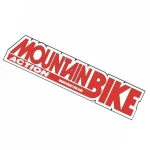Fork Comparison: Manitou Dorado and Mattoc Pro
Manitou Products was founded over 20 years ago with the goal of producing technically advanced suspension components. While the company has been through a number of changes since then, including recently being acquired by the Hayes Bicycle group in 2000, through their decades of extensive R&D testing and competition at both World and National levels, they’ve proven that they’re a force to be reckoned with. This is a suspension company that is willing to swim with the sharks in the already very-developed fork market.
Tech Features: The Dorado’s inverted construction is sure to draw attention on the trail. The fork also features a dual-chamber air spring, TPC+ damping (with independent high- and low-speed compression), hydraulic bottom-out and top-out, and Manitou’s patented HexLock 20mm thru-axle.
The Mattoc offers many of the same features as the Dorado in a smaller, enduro-friendly package. The fork uses a smaller version of the Dorado’s dual-chamber air spring, a TPC damper with MC2 technology with high- and low-speed compression adjustments, and a hydraulic bottom-out control. The Mattoc is available for both 26- and 27.5-inch formats with 5.5-6.3 inches of travel in the 27.5-inch format, or 5.5-6.7 inches in the 26er format. Our 6.3-inch travel, 27.5-inch Mattoc Pro weighed 4.2 pounds with the steerer cut to 8.5 inches. The Mattoc retails for $899.
Field Test Results: The Manitou Dorado has been a staple on Mountain Bike Action’s gravity bikes for some time. Years ago, we gave the technological marvel a five-star rating for its innovative design and excellent damping characteristics. The Mattoc is an enduro fork through and through and fits into Manitou’s lineup as the “little brother” of the Dorado, sporting enough travel to handle the steepest rock-strewn chutes without weighting your front end like you’re towing a boat anchor from your handlebar.
We chose our trusty Intense Tracer 275 as a test bike since the travel and intended riding is right in the wheelhouse for the Temecula, California-made enduro machine. The fork bolted up without issue. We even appreciated the simplicity of cable routing thanks to a single zip tie, located below Manitou’s patented reverse arch, which kept the cable from rubbing.
We started by experimenting with the recommended 53-65psi range for our 180-pound test rider and found it to be on the soft side. We settled for the higher end of the scale at 60psi, which gave us 20-percent sag, and hit the trails.
Right out of the gate, we noticed the Mattoc’s excellent small-bump compliance, which felt very reminiscent of the Dorado we’ve come to know and love. The fork is supple off the top on small hits and provides a super-smooth ride over trail chatter; however, with the fork in the “open” mode and the low-speed compression damper turned down, we found the fork tended to live in the middle of the travel and “hammock.” Fortunately, the low-speed compression has four clicks of adjustment that are easily accessed on the top of the fork leg. Riding the fork just a couple clicks in keeps the fork higher in its travel until you need it and makes the travel more usable. Dialing in the low-speed decreases the small-bump sensitivity, but that’s a sacrifice we’re willing to make to be able to use the travel more effectively. The adjustment’s fourth “fully closed” setting also works very well for extended climbs, where we found ourselves wanting a firm and efficient pedaling platform.
The high-speed compression delivers five clicks of adjustment that make slight but noticeable differences over rocks, roots, and trail chatter. With the adjustment set to the softer side of its range, we found the fork’s small-bump compliance noticeably improved.
The TPC rebound damper has nine clicks of adjustment that easily satisfied our needs. We found ourselves using the lighter side of the scale to keep the fork responsive and higher in its travel for the aggressive and rocky terrain we spent the majority of time riding; however, for smooth and flowing trails, it would be easy dial this up to slow the fork down.
A highlight of the Mattoc’s construction is the HexLock thru-axle, the reverse-arch design and 34-millimeter stanchion tubes that work together for great steering precision. Whereas the Mattoc’s bigger brother the Dorado was not as stiff as we would have liked, the Mattoc delivers this trait in spades. Dive this fork into a hard turn or hard braking effort and it tracks precisely and predictably.
Overall, the feel of the Mattoc puts it right in the mix with the suspension giants. The fork delivers an excellent feel on the trail that’s close to matching the performance of its peers. With a little tuning and a little know-how, the Mattoc is spot on. And, at nearly $200 less than a comparably equipped fork from another company, the Mattoc will satisfy the needs of any aggressive trail or enduro rider.
___________________________________
THERE ARE SO MANY WAYS TO GET MOUNTAIN BIKE ACTION:
Mountain Bike Action is a monthly magazine devoted to all things mountain biking (yes, that’s 12 times a year because we never take a month off of mountain biking). It has been around since 1986 and we’re still having fun. You can start a subscription by clicking here or calling (800) 767-0345. Also available from the Apple Newsstand for reading on your iPad, iPhone or iPod Touch.
Contact us via email at [email protected]
____________________________________







